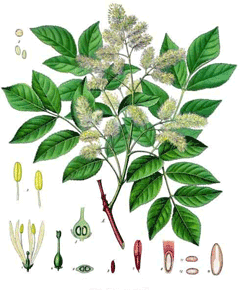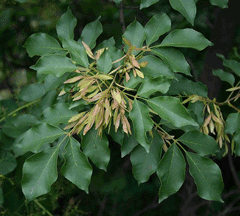 |
|
http://commons.wikimedia.org/wiki/File:Koeh-062.jpg |
 |
| http://commons.wikimedia.org/wiki/User:Franz_Xaver |
Translate this page:
Summary
Bloom Color: Green. Main Bloom Time: Early spring, Late spring, Mid spring.Form: Rounded.
Physical Characteristics

 Fraxinus ornus is a deciduous Tree growing to 9 m (29ft) by 6 m (19ft) at a slow rate.
Fraxinus ornus is a deciduous Tree growing to 9 m (29ft) by 6 m (19ft) at a slow rate.
See above for USDA hardiness. It is hardy to UK zone 6 and is not frost tender. It is in flower in May, and the seeds ripen from September to December. The species is dioecious (individual flowers are either male or female, but only one sex is to be found on any one plant so both male and female plants must be grown if seed is required). and is pollinated by Wind. The plant is not self-fertile.
Suitable for: light (sandy), medium (loamy) and heavy (clay) soils. Suitable pH: mildly acid, neutral and basic (mildly alkaline) soils. It cannot grow in the shade. It prefers dry or moist soil. The plant can tolerates strong winds but not maritime exposure.
It can tolerate atmospheric pollution.
UK Hardiness Map
US Hardiness Map
Synonyms
Ornus europaea
Plant Habitats
Woodland Garden Canopy;
Edible Uses
Edible Parts: Manna
Edible Uses:
Manna - a sweetish exudate is obtained from the stems by incision[2, 4, 11, 114, 171, 183]. The quality is better from the upper stems. A mild sweet taste[114], its main use is as a mild and gentle laxative[171], though it is also used as a sweetener in sugar-free preparations and as an anti-caking agent[238]. The tree trunk must be at least 8cm in diameter before the manna can be harvested[4]. A vertical series of oblique incisions are made in the trunk in the summer once the tree is no longer producing many new leaves[4]. One cut is made every day from July to the end of September. A whitish glutinous liquid exudes from this cut, hardens and is then harvested[2]. Dry and warm weather is essential if a good harvest is to be realised[4]. The tree is harvested for 9 consecutive years, which exhausts the tree. This is then cut down, leaving one shoot to grow back. It takes 4 - 5 years for this shoot to become productive[2]. Average yields of 6 kilos per hectare of top quality manna, plus 80 kilos of assorted manna are achieved[2].
References More on Edible Uses
Medicinal Uses
Plants For A Future can not take any responsibility for any adverse effects from the use of plants. Always seek advice from a professional before using a plant medicinally.
Laxative Tonic
The manna obtained from the trunk is a gentle laxative and a tonic[4, 46]. It is especially valuable for children and pregnant women[4, 238]. Its action is normally very mild, though it does sometimes cause flatulence and pain[4].
References More on Medicinal Uses
The Bookshop: Edible Plant Books
Our Latest books on Perennial Plants For Food Forests and Permaculture Gardens in paperback or digital formats.

Edible Tropical Plants
Food Forest Plants for Hotter Conditions: 250+ Plants For Tropical Food Forests & Permaculture Gardens.
More

Edible Temperate Plants
Plants for Your Food Forest: 500 Plants for Temperate Food Forests & Permaculture Gardens.
More

More Books
PFAF have eight books available in paperback and digital formats. Browse the shop for more information.
Shop Now
Other Uses
References More on Other Uses
Cultivation details
Landscape Uses:Pollard, Specimen. Prefers a deep loamy soil, even if it is on the heavy side[1, 200]. Most members of this genus are gross feeders and require a rich soil[11, 200]. Succeeds in exposed positions[200] and in alkaline soils[11]. Requires a moist soil according to some reports[1, 11] whilst another says that it succeeds in drier soils[200]. Plants are tolerant of atmospheric pollution[200]. Although the dormant plant is very cold-hardy, the young growth in spring, even on mature plants, is frost-tender and so it is best to grow the plants in a position sheltered from the early morning sun[K]. A very ornamental plant[1], the manna ash is cultivated for its edible manna in Sicily and Calabria[89, 142]. The flowers are sweetly scented[245]. Trees have a very dense canopy[11]. Dioecious. Male and female plants must be grown if seed is required. Special Features:Not North American native, Attractive flowers or blooms.
References Carbon Farming Information and Carbon Sequestration Information
Temperature Converter
Type a value in the Celsius field to convert the value to Fahrenheit:
Fahrenheit:
The PFAF Bookshop
Plants For A Future have a number of books available in paperback and digital form. Book titles include Edible Plants, Edible Perennials, Edible Trees,Edible Shrubs, Woodland Gardening, and Temperate Food Forest Plants. Our new book is Food Forest Plants For Hotter Conditions (Tropical and Sub-Tropical).
Shop Now
Plant Propagation
The seed is best harvested green - as soon as it is fully developed but before it has fully dried on the tree - and can then be sown immediately in a cold frame[80]. It usually germinates in the spring[80]. Stored seed requires a period of cold stratification and is best sown as soon as possible in a cold frame[200]. Prick out the seedlings into individual pots when they are large enough to handle and grow them on in a cold frame for their first winter. Plant them out into their permanent positions or a nursery bed in late spring or early summer of the following year. If you have sufficient seed then it is possible to sow it directly into an outdoor seedbed, preferably in the autumn. Grow the seedlings on in the seedbed for 2 years before transplanting either to their permanent positions or to nursery beds.
Other Names
If available other names are mentioned here
Native Range
TEMPERATE ASIA: Lebanon, Syria, Turkey EUROPE: Czechoslovakia, Austria, Switzerland, Hungary, Former Yugoslavia, Albania, Bulgaria, Greece, Italy (incl. Sicily), Romania, Spain, France (incl. Corsica)
Weed Potential
Right plant wrong place. We are currently updating this section.
Please note that a plant may be invasive in one area but may not in your area so it's worth checking.
Conservation Status
IUCN Red List of Threatened Plants Status :

Growth: S = slow M = medium F = fast. Soil: L = light (sandy) M = medium H = heavy (clay). pH: A = acid N = neutral B = basic (alkaline). Shade: F = full shade S = semi-shade N = no shade. Moisture: D = dry M = Moist We = wet Wa = water.
Now available:
Food Forest Plants for Mediterranean Conditions
350+ Perennial Plants For Mediterranean and Drier Food Forests and Permaculture Gardens.
[Paperback and eBook]
This is the third in Plants For A Future's series of plant guides for food forests tailored to
specific climate zones. Following volumes on temperate and tropical ecosystems, this book focuses
on species suited to Mediterranean conditions—regions with hot, dry summers and cool, wet winters,
often facing the added challenge of climate change.
Read More
Expert comment
Author
L.
Botanical References
1150200
Links / References
For a list of references used on this page please go here
Readers comment